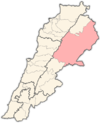Qaa
القاع El Qaa, Al Qaa | |
|---|---|
| Coordinates: 34°20′37″N 36°28′32″E / 34.34361°N 36.47556°E | |
| Country | |
| Governorate | Baalbek-Hermel |
| District | Baalbek |
| Government | |
| • Type | Municipality |
| • Mayor | Bachir Matar |
| Area | |
| • Total | 4.98 sq mi (12.91 km2) |
| Elevation | 2,156 ft (657 m) |
| Population (2010)[1] | |
| • Total | 500 |
| Time zone | UTC+2 (EET) |
| • Summer (DST) | +3 |
| Alternative name | El Qaa |
|---|---|
| Location | Beqaa Valley, Lebanon |
| Part of | Type site |
| History | |
| Periods | Shepherd Neolithic |
| Site notes | |
| Archaeologists | M. Billaux, Henri Fleisch |
| Condition | ruins |
| Public access | Yes |

Qaa (Arabic: القاع), El Qaa, Al Qaa, Qaa Baalbek or Masharih al-Qaa is a town in Baalbek-Hermel Governorate, Lebanon.[2] A 2010 report stated that population of the settlement was 500, all Lebanese Maronites
YouTube Encyclopedic
-
1/5Views:61947 3042 91312 03318 052
-
What is QAA Membership?
-
What is quality assurance?
-
ChatGPT: What should assessment look like now?
-
QAA - Higher Education, a Global Brand
-
QAA - The UK Quality Code
Transcription
History
In 1838, Eli Smith noted Qaa's population as being predominantly Catholic Christian.[3]
On June 28, 1978, unidentified militiamen killed twenty-six villagers from Qaa and three other villages. The murders were believed to be connected to the killing of thirty-four people, including Tony Franjieh, on 13 June. The gunmen were reported to have had lists of names from which they selected their victims.[4]
The Syrian army invaded Lebanon at 4 a.m. on 1 September 2012 and kidnapped a farmer from the town as part of escalating incursions during the Syrian civil war. The invasion lasted for forty minutes before the unit withdrew. A house in Qaa had previously been hit by a shell fired by the Syrian army.[5]
On the 27 June 2016, at least five people in Qaa were killed and thirteen others wounded in an attack by four suicide bombers during the Syrian Civil war spillover into Lebanon.[6][7][8]
Archaeology
Along with Maqne I, Qaa is a type site of the Shepherd Neolithic industry. The site is located 5 miles (8 km) north west of the town, north of a path leading from Qaa to Hermel. It was discovered by M. Billaux and the materials recovered were documented by Henri Fleisch in 1966.[9] The area was lightly cultivated with a thin soil covering the conglomerates. The flints were divided into three groups of a reddish brown, light brown and one that was mostly chocolate and grey colored with a radiant "desert shine".[2]
The Shepherd Neolithic industry can be defined firstly by being small and thick in size, with flakes commonly ranging from 2.5 centimetres (1.0 in) to 4 centimetres (1.6 in), the thickness distinguishing them from geometric microliths. Their second characteristic is the limited number of forms that the tools take, apart from cores being transverse racloirs on small flakes, strong-pointed borers, denticulated or notched thick, short blades and end-scrapers. It was thirdly characterized by a lack of known typology, with only occasional use of Levallois technique. It was determined to be definitely later than the Mesolithic but without any usual forms from the Upper Paleolithic or pottery Neolithic. Henri Fleisch tentatively suggested the industry to be Epipaleolithic and suggested it may have been used by nomadic shepherds.[2] The Shepherd Neolithic has largely been ignored and understudied following the outbreak of the Lebanese civil war.
See also
References
- ^ "The Forgotten Turks: Turkmens of Lebanon" (PDF). Centre for Middle Eastern Strategic Studies. Feb 2010. Archived from the original (PDF) on March 3, 2016. Retrieved May 8, 2015.
- ^ a b c L. Copeland; P. Wescombe (1966). Inventory of Stone-Age Sites in Lebanon: North, South and East-Central Lebanon, p. 49. Impr. Catholique. Retrieved 29 August 2011.
- ^ Robinson and Smith, 1841, vol 3, 2nd appendix, p. 144
- ^ "Lebanese Christians Are Slain by Gunmen". The New York Times. 29 June 1978.
- ^ "Syrian army crosses into Lebanon, snatches farmer". The Daily Star (Lebanon).
- ^ "Lebanon: Christian village hit by multiple suicide attacks". BBC News. 27 June 2016.
- ^ "Suicide bombers strike Lebanese village, kill five". U.S. 27 June 2016 – via Reuters.
- ^ Andrew Doran (28 June 2016). "ISIS in Lebanon: The courage of a Christian town on the frontline of Jihad". Newsweek.
- ^ Fleisch, Henri., Notes de Préhistoire Libanaise : 1) Ard es Saoude. 2) La Bekaa Nord. 3) Un polissoir en plein air. BSPF, vol. 63, 1966.


